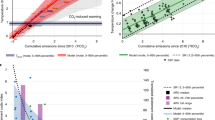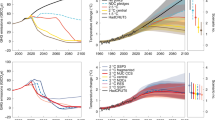Abstract
For more than a decade, the target of keeping global warming below 2 °C has been a key focus of the international climate debate1. In response, the scientific community has published a number of scenario studies that estimate the costs of achieving such a target2,3,4,5. Producing these estimates remains a challenge, particularly because of relatively well known, but poorly quantified, uncertainties, and owing to limited integration of scientific knowledge across disciplines6. The integrated assessment community, on the one hand, has extensively assessed the influence of technological and socio-economic uncertainties on low-carbon scenarios and associated costs2,3,4,7. The climate modelling community, on the other hand, has spent years improving its understanding of the geophysical response of the Earth system to emissions of greenhouse gases8,9,10,11,12. This geophysical response remains a key uncertainty in the cost of mitigation scenarios but has been integrated with assessments of other uncertainties in only a rudimentary manner, that is, for equilibrium conditions6,13. Here we bridge this gap between the two research communities by generating distributions of the costs associated with limiting transient global temperature increase to below specific values, taking into account uncertainties in four factors: geophysical, technological, social and political. We find that political choices that delay mitigation have the largest effect on the cost–risk distribution, followed by geophysical uncertainties, social factors influencing future energy demand and, lastly, technological uncertainties surrounding the availability of greenhouse gas mitigation options. Our information on temperature risk and mitigation costs provides crucial information for policy-making, because it clarifies the relative importance of mitigation costs, energy demand and the timing of global action in reducing the risk of exceeding a global temperature increase of 2 °C, or other limits such as 3 °C or 1.5 °C, across a wide range of scenarios.
This is a preview of subscription content, access via your institution
Access options
Subscription info for Japanese customers
We have a dedicated website for our Japanese customers. Please go to natureasia.com to subscribe to this journal.
Buy this article
- Purchase on SpringerLink
- Instant access to full article PDF
Prices may be subject to local taxes which are calculated during checkout



Similar content being viewed by others
References
Randalls, S. History of the 2 °C climate target. Clim. Change 1, 598–605 (2010)
Clarke, L. et al. International climate policy architectures: overview of the EMF 22 International Scenarios. Energy Econ. 31, S64–S81 (2009)
Edenhofer, O. et al. The economics of low stabilization: model comparison of mitigation strategies and costs. Energy J. 31, 11–48 (2010)
UNEP. Bridging the Emissions Gap 15–20 (United Nations Environment Programme, 2011)
O’Neill, B. C., Riahi, K. & Keppo, I. Mitigation implications of midcentury targets that preserve long-term climate policy options. Proc. Natl Acad. Sci. USA 107, 1011–1016 (2010)
Core Writing Team, Pachauri, R. K. & Reisinger, A. (eds) Climate Change 2007: Synthesis Report (Intergovernmental Panel on Climate Change, 2007)
Riahi, K. et al. in Global Energy Assessment: Toward a Sustainable Future 1203–1306 (Cambridge Univ. Press, 2012)
Friedlingstein, P. et al. Climate–carbon cycle feedback analysis: results from the C4MIP model intercomparison. J. Clim. 19, 3337–3353 (2006)
Meehl, G. A., Covey, C., McAvaney, B., Latif, M. & Stouffer, R. J. Overview of the coupled model intercomparison project. Bull. Am. Meteorol. Soc. 86, 89–93 (2005)
Meehl, G. A. et al. in IPCC Fourth Assessment Report (eds S. Solomon et al.) 747–847 (Cambridge Univ. Press, 2007)
Meinshausen, M., Wigley, T. M. L. & Raper, S. C. B. Emulating atmosphere-ocean and carbon cycle models with a simpler model, MAGICC6 – Part 2: applications. Atmos. Chem. Phys. 11, 1457–1471 (2011)
Archer, D. et al. Atmospheric lifetime of fossil fuel carbon dioxide. Annu. Rev. Earth Planet. Sci. 37, 117–134 (2009)
Schaeffer, M., Kram, T., Meinshausen, M., van Vuuren, D. P. & Hare, W. L. Near-linear cost increase to reduce climate-change risk. Proc. Natl Acad. Sci. USA 105, 20621–20626 (2008)
Rao, S. & Riahi, K. The role of non-CO2 greenhouse gases in climate change mitigation: long-term scenarios for the 21st century. Energy J. 27, 177–200 (2006)
Riahi, K., Gruebler, A. & Nakicenovic, N. Scenarios of long-term socio-economic and environmental development under climate stabilization. Technol. Forecast. Social Change 74, 887–935 (2007)
Meinshausen, M., Raper, S. C. B. & Wigley, T. M. L. Emulating coupled atmosphere-ocean and carbon cycle models with a simpler model, MAGICC6 – Part 1: Model description and calibration. Atmos. Chem. Phys. 11, 1417–1456 (2011)
Rogelj, J., Meinshausen, M. & Knutti, R. Global warming under old and new scenarios using IPCC climate sensitivity range estimates. Nature Clim. Change 2, 248–253 (2012)
Knutti, R. et al. A review of uncertainties in global temperature projections over the twenty-first century. J. Clim. 21, 2651–2663 (2008)
Mastrandrea, M. D. et al. Guidance Note for Lead Authors of the IPCC Fifth Assessment Report on Consistent Treatment of Uncertainties 3 (Intergovernmental Panel on Climate Change, 2010); available at http://www.ipcc.ch/pdf/supporting-material/uncertainty-guidance-note.pdf
Smith, S. M. et al. Equivalence of greenhouse-gas emissions for peak temperature limits. Nature Clim. Change 2, 535–538 (2012)
UNFCCC. FCCC/CP/2010/7/Add.1 Decision 1/CP.16 3 (UN Framework Convention on Climate Change, 2010)
Smith, S. J. & Edmonds, J. A. The economic implications of carbon cycle uncertainty. Tellus B 58, 586–590 (2006)
Vaughan, N. & Lenton, T. &. Shepherd, J. Climate change mitigation: trade-offs between delay and strength of action required. Clim. Change 96, 29–43 (2009)
den Elzen, M., van Vuuren, D. & van Vliet, J. Postponing emission reductions from 2020 to 2030 increases climate risks and long-term costs. Clim. Change 99, 313–320 (2010)
Bosetti, V., Carraro, C., Sgobbi, A. & Tavoni, M. Delayed action and uncertain stabilisation targets. How much will the delay cost? Clim. Change 96, 299–312 (2009)
Krey, V. & Riahi, K. Implications of delayed participation and technology failure for the feasibility, costs, and likelihood of staying below temperature targets: greenhouse gas mitigation scenarios for the 21st century. Energy Econ. 31, S94–S106 (2009)
UNFCCC. FCCC/CP/2011/9/Add.1 Decision 1/CP.17 (UN Framework Convention on Climate Change, 2011)
UN. World Population Prospects: The 2008 Revision Population Database (United Nations, 2009)
Nakicenovic, N. & Swart, R. IPCC Special Report on Emissions Scenarios (Cambridge Univ. Press, 2000)
Meinshausen, M. et al. Greenhouse-gas emission targets for limiting global warming to 2°C. Nature 458, 1158–1162 (2009)
Acknowledgements
We thank V. Krey, P. Kolp and M. Strubegger for their support in developing the model set-up and extracting the results, R. Knutti and R. Socolow for comments and feedback during the writing process and S. Hatfield-Dodds, whose review comments substantially contributed to improving our manuscript. J.R. was supported by the Swiss National Science Foundation (project 200021-135067) and the IIASA Peccei Award Grant.
Author information
Authors and Affiliations
Contributions
All authors were involved in designing the research. J.R. performed the research in collaboration with D.L.M. All authors contributed to writing the paper.
Corresponding author
Ethics declarations
Competing interests
The authors declare no competing financial interests.
Supplementary information
Supplementary Information
This file contains Supplementary Text 1-3, which includes background information about our modelling framework, setup and results, Supplementary Tables 1–2, Supplementary Figures 1-10, Supplementary References. This file was replaced on 15 January 2014 and contains updated versions of Supplementary Figures 2, 3, 4, 5, 8, and 9, in line with the description in the Corrigendum 10.1038/nature12937. None of these changes affect our conclusions or discussion of results. (PDF 2632 kb)
Supplementary Data
This file contains a Cost-Risk Check Tool, which allows for interactive querying of our cost-risk distributions for 1.5, 2, 2.5, and 3°C. Different cost metrics can be selected for various energy supply and demand combinations. This file was replaced on 15 January 2014. (XLSX 204 kb)
Rights and permissions
About this article
Cite this article
Rogelj, J., McCollum, D., Reisinger, A. et al. Probabilistic cost estimates for climate change mitigation. Nature 493, 79–83 (2013). https://doi.org/10.1038/nature11787
Received:
Accepted:
Published:
Issue Date:
DOI: https://doi.org/10.1038/nature11787
This article is cited by
-
Advancing green finance: a review of climate change and decarbonization
Digital Economy and Sustainable Development (2024)
-
New damage curves and multimodel analysis suggest lower optimal temperature
Nature Climate Change (2023)
-
The Impact of Transitory Climate Risk on Firm Valuation and Financial Institutions: A Stress Test Approach
Schmalenbach Journal of Business Research (2023)
-
Thailand’s mid-century greenhouse gas emission pathways to achieve the 2 degrees Celsius target
Energy, Sustainability and Society (2022)
-
Uncertain storage prospects create a conundrum for carbon capture and storage ambitions
Nature Climate Change (2021)



